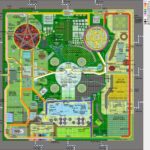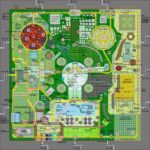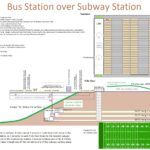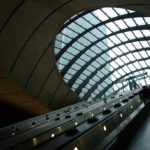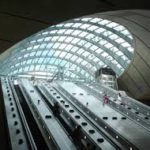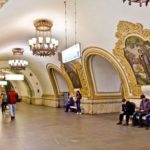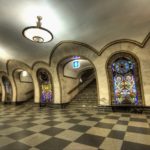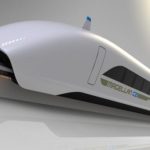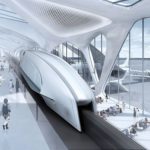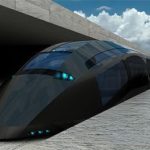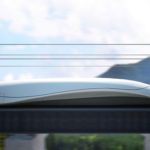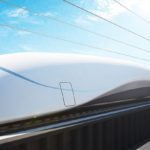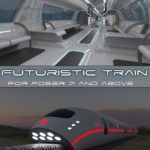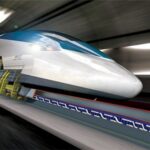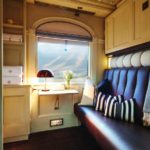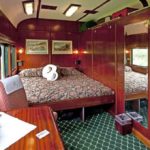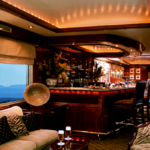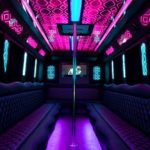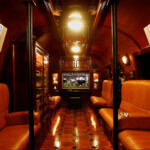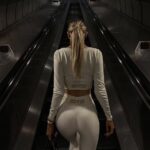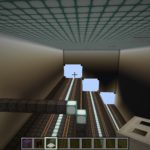Silently running beneath and alongside (parallel with) all our highway sections… is this.
–
Table of Contents:
- Introduction
- Dimensions & Layout
- Subway Stations Directory
- Total Number of Subway-trains
- Subway-train Speed
- Time to Board and Detrain
- Time at Each Station
- Meal & Beverage Service
- Special Features
- Restricted Access Routes
- History
- Routes / Lines
- City-map Showing All Stations (Images Begin)
- Design
- Station Concepts
- Train-exterior Concepts
- Train-interior Concepts
- Every Seat and Sleeper Room Comes with an Inisfreean Girl
- 2022 Update: Minecraft 1:1 Build
- For Reference
- For Fun
- 2024 April/+
–
Introduction:
Inisfree’s subway system runs parallel to its surface highway sections.
It is one of the fastest forms of transportation in the city, as its trains (can) travel at speeds above 380 MPH (meaning it can go all the way around the 40-mile near-wall highway-‘loop’ of our city in under 15 minutes (factoring in the time it takes to accelerate, then to decelerate), though this time is ~doubled due various factors, such as potential stops at the many subway-stations along the way).
- 380 MPH = 33,440’/minute (MPM)
- 40 miles = 211,200′
- 211,200′ / 34,440′ (MPM) = ~6.13 minutes
- time needed to reach 380 MPH: 12.7 seconds
- time needed to decelerate from 380 MPH: 12.7 seconds
Each of its trains is as luxurious as any mansion you might explore on the city’s surface; each subway train car has thrones instead of chairs, canopy beds instead of benches, jacuzzis instead of booths, chandeliers instead of light-bulb indentions, studded Corinthian leather instead of plastic, sheets of diamond and transparent metals instead of glass, Oriental rugs and vicuna throws (which subway users enjoy standing and walking barefoot on) instead of carpeting, and gold painting frames bordering each of its LCD-maps showing riders where they are along the Inisfreean subway routes.
Its trains are also cavitating (due to both standard cavitation methods, as well as Repulsines) to help with noise reduction and air friction negation.
Whenever you want to get to the opposite side of the city in about five minutes flat, just hop into the next subway car once its train smoothly pulls into the next (and equally luxurious) subway station and waiting platform, and off you go.
–
Dimensions & Layout:
Inisfreean subway trains, and their subway train cars, are the same size as double-decker trains and their cars in the Outlands; this is to allow ample room for their canopy beds and chandeliers. Each of our subway-cars has two boarding/disembarking areas; one near its front, and one near its back. Each also has a dining area / lounge, and a hallway on each of its two levels to all of its private rooms.
Subway-track:
- ~33′ wide per track/terrace
- ~120 miles before including the GAH-spiral in the Auz’dome
- turns/curves below GAH-intersections on the surface: radius = ~350′ (turn-radius based on a circle whose circumference is 4x the length of the train), length = 545′, thus fits in a 6×6 map-pixels area, thus fits underneath each GAH-intersection
Subway-train:
- Each subway-train of ours has 7 subway-cars.
- ~545′ “long” (deep)
- capacity: 280 human-sized passengers
- cruising speed: ~380 MPH
- stops only at stations the passengers need (and this is known either by 1) detected user-thoughts, or 2) reservations), thus sometimes having time to accelerate to top-speed between far-enough-apart stations
- 33 total for Inisfree (and for any Inisfree-like city; the other CSBSs in our fleet/empire)
Subway-car:
- Each subway-car has two levels, 20 bedrooms total, 10 per level, 5 per side of those levels.
- ~77′ “long” (deep)
- ~22′ wide
- ~20′ tall
- capacity: 40 human-sized passengers
- There are two mini-A.I.O.W.s in each of our subway-cars; one is at the front, one is at the back. They are several feet in diameter, and have a spiral staircase, a wall-less elevator/lift, and jungle-gym climbing-bars like multiple ladders stuck together, but no slide, climbing ropes, or zip-lines. An open archway allows people to enter/exit them from/at their top/bottom.
Subway-car Room:
- The rooms are ~6’W x ~8’D x ~9’H,
- and the hallway between the rows/sides of rooms is ~4′ wide; each of our subway cars is ~77′ from front to back (which includes a front-stairwell, a front lounge/eatery, a back lounge/eatery, and a back-stairwell), ~22′ wide, and 20′ tall (making each of our subway-trains ~545′ long).
- capacity: 2 human-sized passengers
- Since each room has a double/bunkbed, the capacity of each of these subway-trains is 280 human-sized people (as only one can sleep comfortably per bed, even though two petite females could fit).
- beds: ~7’D x ~3’W, the lowest bed’s mattress-surface/top being ~2′ above the room-floor, and the upper bed’s bottom being ~3′ above it
- The rooms have one door on the hallway-side, and one window on the hull-side.
- They have one sink, one toilet, one bench, and one bunkbed.
- Lights are indirect and have ‘mood’ (color-changing) options, not just a brightness and on/off control.
- (There is little/no need to have “sleeper rooms” like this, due to how fast our train/subway is, but we prefer to offer luxury and privacy to all our guests/riders; we don’t ever have tiny seats crammed together, side by side, like Outlanders have in their subways and planes.)
- To maintain more walking space and ‘elbow room’, all furniture, such as those beds, are kept to one side of each subway-car’s side, and the side they are on (in/along each side) is alternated back and forth from car to car along each train; this is to keep the weight distribution even overall.
- All furniture is fused with the rest of its respective subway train car’s structure, such that it is immovable even without having bolts or clamps to hold it down (and inertial dampeners, among other things, help to keep it perfectly in place, too; not even the pillows shift around during rapid accelerations and decelerations).
Subway Station:
- The subway stations are triple-decker and cascading; three train tracks run side by side, overall on a 45° slope (though it is actually three flat planes/’steps’; normal terraces), such that from one side, anyone on any of those levels can see all three tracks and their trains when they pull into the station at or near the same time.
- To cross the tracks, pedestrians go up or down to the waiting-rooms alongside the other terraces, then through a subway-car to the other side.
- Every loop/route in our subway system has three tracks running along/through it, thus three available subway-trains at all times along that route. (11 loops/routes x 3 = 33 subway-trains)
- 3 levels; 1 per track/terrace
- 4 AIOWs; at ~even intervals along the bus-station side of each subway-station, corresponding to the bus-station AIOWs
- Since the subway runs parallel beneath the highway sections, a tunnel connects those AIOWs to the 3 waiting-areas/levels.
- 33′-wide tracks/terraces; 99′ for all 3 side-by-side
- Waiting Areas: only a couple-dozen feet from track/terrace-wall to the wall farthest from the tracks/terraces
545′-long; same as the length of 1 subway-train
13,080 sq.ft. per waiting-area/level; room for ~523 human-sized passengers
2 waist-level fence-like gates per subway-car stopping-length; aligned to the 2 doors per subway-car (thus 14 gates per waiting-room)
Upper: 545′ long x 24′ wide, with 2 ~549.5′-long tunnels; 1 to each of the 2 outer AIOWs connecting to the surface (bus-station above), and 2 shorter tunnels; to each of the 2 inner AIOWs
Middle: 545′ long x 24′ wide, with 2 ~573.5′-long tunnels; 1 to each of the 2 outer AIOWs connecting to the surface (bus-station above), and 2 shorter tunnels; to each of the 2 inner AIOWs
Lower: 545′ long x 24′ wide, with 2 ~597.5′-long tunnels; 1 to each of the 2 outer AIOWs connecting to the surface (bus-station above), and 2 shorter tunnels; to each of the 2 inner AIOWs
Total Capacity (all 3 levels combined): 1,569 human-sized people waiting for a subway-train - station width: 123′ (99′ + 24′ of upper waiting-room)
- terrace height: 27′
- station height: 81′ (except for the private/restricted station alongside the Batcave II facility; 108′-height for that one)
- dispersion: corresponding to the bus-stations (which are 388′ long, and every ~1/4-mile along the highway), these subway-stations (545′ long) are 775′ apart (1,320′ – 545′)
- 770 subway-stations; matching the bus-stations overhead –in 562 cases (because 208 of the subway-stations are deep underground in restricted areas)
Station AIOWs:
- 33′-diameter
- all the usual/standard features for mid-sized AIOWs
- connected to each waiting-room/level/terrace by 1 tunnel
- connecting-tunnels: ~20′ wide, ~10′ tall, lit all the way (not just based on presence and motion), and with 2 moving-walkways (1 per side/wall)
- Since the corresponding bus-stations are sometimes on different sides of the highway, to keep all these tunnels the same length per level… all subway-stations are centered underneath the highway, based on their middle track/terrace.
- 638′ from the center of an AIOW to the middle of the middle track/terrace of its corresponding subway-station
- time to (at the avg. ~3 MPH) walk from one of these AIOWs to a subway-station waiting-level/room: ~2 minutes
- time to go from one of these AIOWs, via a moving-walkway, to a subway-station waiting-level/room: (same; these are just designed to spare you the effort)
There are no subway stations in the following places:
- along/beneath the Sotu perimeter-ring’s above-moat GAH-ring; in the Sotu perimeter-wall
- along/beneath the uppermost GAH-ring of Sotu; atop the Sotu perimeter-wall
- the city’s (Inisfree’s) perimeter wall; ICVs teleport/portal on/off duty there, needing no subway
- along/beneath the Underway‘s GAH-section
–
Subway Stations Directory:
There are dozens of ‘stops’ in our city, allowing you to only have a short walk or ride/drive once you step off the (subway) train. The following are the main ones (most frequented), all of which were operational during the 2010s (2013 and on).
- Amusement Park / Sea-tanks / Zoo
- Apartments Array / Earthships neighborhood / Waterfall City II “North”
- Apartments Array / Earthships neighborhood / Waterfall City II “South”
- Arch City / X-2 Spinners hotel
- Atlantis II hotel / Giant Sand-castle / San Diego Hills neighborhood
- Auz’dome “East” / Slant-top Spire
- Auz’dome “Northeast”
- Auz’dome “Northwest” / Palaces neighborhood
- Auz’dome “South” / Cliff-dwelling neighborhood 1 of 3
- Auz’dome “West” / “Mosques” neighborhood
- Beach Strip / Piers
- Bora-tiki / Santorini II
- Canyon / Cliff-dwelling neighborhood 2 of 3
- Chinese Great Gate / Welcoming Square
- Civilian Aerospaceport
- Clothing Factory / MKM Distribution facility
- Coliseum Amphitheater / PB-PK Carrier / PB-PK Wedge
- Cropland / Giant Baobab
- Devils Tower II
- Downtown (Sotu)
- Floating Oasis Cylinders / Mountain on Corinthians
- Flower Towers field
- Governor’s Mansion (its 2nd/middle basement level)
- Grocery Store / Giant Geode
- Highway Cathedral / Automated Factories row
- Highway Sphinx
- Holistic Hospital
- Inverted Pyramid / Paintball Warfare Area
- Kajirae-candidates Training Facility (Girl Kennels; Underground Prison) / Receiving Facility (Underground Quarantine)
- Liberty High School (LHS) / SCUBA City
- Luxor II hotel
- Mall / Dropship Theater
- Military Aerospaceport / Cut Pyramid
- N.W.O. Military Training barracks/base/facilities
- Slanted-toroids Buildings complex / Double-tree hotel
- Spire Temple / Snowmobile Racetrack
- Statue Park / Borg-cube Apartments building
- Swamp / Obstacle Course / Halo Maps
- Tornado Crater / Overhang Base
- Tree-castles Complex / Golf Course
- Valhalla II / Tantric Academy
- WMKM Studios / Disc Pond
- White Pail-shaped Buildings complex / Beach-assault Landing-zone
- White Pyramids complex / Chateaux neighborhood
At all of these stations, the top track goes one way, the bottom track sends subway-trains the other direction, and the middle track is variable. All subway-trains on all tracks can be stopped and sent back the other way, always based 1) first on where other subway-trains are going (to prevent collisions), and 2) second on requests/demand.
See below for a map of how these stations are grouped into loops.
*Some stations are not listed above because they are classified / restricted-access.
–
Total Number of Subway-trains:
Again, every loop/route in/of our subway-system has a terraced triple-decker set of offset subway-tracks, and three subway-trains; one per track/level. There are 11 loops/routes in our subway-system. That means there are 33 subway-trains in Inisfree (as well as in all the Inisfree-like cities on/in the worlds of Star-System Auzdein (SSA)).
–
Subway-train Speed:
The following explains why our subway-trains (at least those on the upper terrace/track of this system) usually only accelerate to 225 MPH, not 380/+.
- Accelerating ~60 (more) MPH every 2 seconds, within 12.7 seconds any of this system’s trains can reach/exceed 380 MPH; their top cruising-speed.
- 380 MPH = 2,006,400’/hour; 33,440’/minute; ~557.33’/second
- With ~775′ between subway-stations, to get to an adjacent station… a subway-train must cover that distance plus its own length; 775 + 1,320′, exactly 1/4 of a mile.
- 1,320′ at 557.33’/second = 2.3684210526315789473684210526316 seconds
However, that is at top speed; 380 MPH. It takes these trains 12.7 seconds to accelerate to that speed. - Accelerating for 2 seconds gets these trains up to 60 MPH (88’/second), which is 10 MPH faster than the average Outlander/human subway-train’s cruising speed, and which would get them to an adjacent station in 15 seconds. (A person walking from station to station (on the surface) would need ~5 minutes; 20x longer.)
- 15 seconds is long enough to reach their top speed, of course, but half the distance between stations/stops must be used for slowing back down to a complete stop; a train going to a station 1/4-mile away will only have 7.5 seconds to accelerate as much as it can.
- 7.5 seconds is enough for any of these trains to reach ~225 MPH.
- 225 MPH = 1,188,000’/hour; 19,800’/minute; 330’/second
- For the 1 second just after the halfway point of a 1/4-mile-apart adjacent-stations movement, the subway-train could be covering 330’/second. 1,320′ – 330′ = 990′ to cover in the remaining seconds.
- Thus we can estimate that these trains cover a 1/4-mile at an average speed between 60 and 225 MPH.
- Halfway between 225 and 60 MPH is 142.5 MPH.
- At 142.5 MPH (209’/second), a train would cover a 1/4-mile in ~6.3 seconds.
In short, at their average/usual speed, time between stations 1/4-mile apart is ~6-7 seconds. (Again, compare that to 5/+ minutes needed if walking that same distance.)
–
Time to Board and Detrain:
Most subways in the Outlands allow 15 to 30 seconds for boarding/detraining; they keep their doors open at least that long at each stop. After that, the trains move on schedule, no matter what.
In our subway-system here in Inisfree, we keep subway-car doors (on the waiting-rooms/levels side of the track) open until there is a passenger boarding; once there is a passenger inside one of our subway-trains (with a destination reserved, or at least in mind)… that train’s timer starts counting down from 15 seconds. At 0, all the doors that were open… close. 1 second later, and the train is accelerating (to 60 MPH in 2 seconds, and another 60 MPH faster within every following 2 seconds, until acceleration is stopped at either the halfway point along the planned movement (track portion) or when the train reaches 380 MPH).
At each destination/station/stop, the doors on the waiting-rooms/levels side of the subway-train will reopen, and they will stay open until either 1) a passenger boards, or 2) the Grid Mind determines that it will be best to move the empty train out of the way of another train which has been requested to move to its position.
Thus, with a ~7-second time between 1/4-mile-apart stations, and ~half-minute overall movement-time, a subway-train’s doors could be kept open for 11.5 seconds on either end (at adjacent stations).
40 people per subway-car means, when a subway-car is full, and when everyone intends to detrain at the next stop, that 20 people will be using each of its 2 waiting-rooms/levels-side doors to detrain. It takes less than 1 second for 1 of them to detrain through those open doors, and all 20 can detrain within 11.5 seconds, though several more seconds are usually allotted/allowed. The extra time is for another 20 people to board per door after the others have detrained; up to capacity.
When operating nonstop, roughly 1 minute is allotted between 1/4-mile stops; 26.5 seconds for the doors to stay open at the departure station, followed by several seconds to move from that station to an adjacent station, and then another 26.5 seconds for the doors to be reopened for detraining and boarding at that adjacent/destination station. This can be reduced to ~half a minute for that cycle, though that is only done during high-demand/usage many millennia in the future.
–
Time at Each Station:
770 subway stations… and 33 subway-trains… could be averaged out such that 1/each train covers ~24 stations. However, subway-trains in our system almost always stay on their own color/line, so there are always only 3 trains for all the stations along/on that line.
- Red Line (military): 52+ stations; each train handling at least 18
- Orange Line (sports): 25+ stations; each train handling at least 9
- Yellow Line (mansions): 16+ stations; each train handling at least 6
- Green Line (farmland): 20+ stations; each train handling at least 7
- Blue Line (lake): 26+ stations; each train handling at least 9
- Purple Line (Auz’dome): 307* stations; each train handling at least 103
- Pink Line (Welcoming area): 51+ stations; each train handling at least 17
- White Line (summit): 18+ stations; each train handling at least 6
- Gray Line (downtown): 23 stations; each train handling at least 8
- Black Line (restricted): 209** stations; each train handling at least 70
- Brown Line (smaller-dwelling neighborhoods): 18+ stations; each train handling at least 6
(The “+” is in reference to the 5 surface-stations not specifically linked/included by those lines.)
*There are 307 stations for the Purple Line because the Auz’dome includes a 400,000′ GAH-section; >75 miles, with a station every 1/4-mile; 303 of them.
**There are 209 stations for the Black Line because of 1) the miles-long underground hangars, 2) the mile-diameter underground repulsines, and 3) the ring around the Stasis Archives and Main Womb.
Over the course of 1 Earth-day (24 hours), that could mean the following:
- Red Line (military): each of its 3 trains spending no more than 80 minutes at each station (thus a possible 80-160 stops per station per day, depending on whether these trains are on 1-minute or half-minute station-to-station schedules; every 18 or 9 minutes)
- Orange Line (sports): each of its 3 trains spending no more than 160 minutes at each station
- Yellow Line (mansions): each of its 3 trains spending no more than 240 minutes at each station
- Green Line (farmland): each of its 3 trains spending no more than 205 minutes at each station
- Blue Line (lake): each of its 3 trains spending no more than 160 minutes at each station
- Purple Line (Auz’dome): each of its 3 trains spending no more than (almost) 14 minutes at each station (thus a possible 14-28 stops per station per day; every ~102 or ~51 minutes)
- Pink Line (Welcoming area): each of its 3 trains spending no more than 84 minutes at each station
- White Line (summit): each of its 3 trains spending no more than 240 minutes at each station
- Gray Line (downtown): each of its 3 trains spending no more than 180 minutes at each station
- Black Line (restricted): each of its 3 trains spending no more than 20 minutes at each station
- Brown Line (smaller-dwelling neighborhoods): each of its 3 trains spending no more than 240 minutes at each station
Also, the trains move based on need/reservations, and that typically means more activity at the stations alongside the most-densely-populated neighborhoods and most-frequently-visited attractions, and sometimes no activity/stops at all at the other stations (at least for many years).
–
Meal & Beverage Service:
A variety of most-popular drinks & entrees from many of the restaurants in our city are available on each of our subway trains. You will always be able to order fresh:
- chips
- cookies
- juices
- muffins
- pastries
- quiches
- sandwiches
- teas
- vegan meat/cheese alternatives
- water
Most people, however, use our subway for its speedy convenience; there is little time to eat and order food before their next stop. Sometimes even ordering a drink takes a bit longer than arriving at the intended station.
–
Special Features:
All of these trains are two-way; they can stop at any station, then start going in the opposite direction, as needed. This is normal especially on the Gray Line, as it includes tracks which meet at the tips of the horizontal five-point star-pattern streets-layout of our downtown area called Sotu; the trains will approach one of those points/tips, stop at the station just outside/beyond them (outside Sotu), then start going in the other direction once the passengers are onboard/seated, guiding onto the other track that makes the other side of that star-point’s tip.
As you are (as your subway-train is) approaching a station, a sexy Inisfreean (ICV) voice comes on the intercom (or mind-interface), using her horny/slutty speech/accent to say that station’s name in this format: “Now approaching… downtown Inisfree. Mmmmm. Have fun!”
Any time a request is made to ride a subway-train all the way around “the Inisfree loop” (~40 miles of near-perimeter subway-tunnels), the four color-coded subway-lines/sections all move their lower-terrace subway-train (at least out of the way, if not all the way around), ensuring there is zero chance of a collision. Within the first 12.7 seconds of travel, the subway-train moving to complete this loop will have reached/exceeded 380 MPH. ~12.7 seconds before reaching its destination (the station where it started, in this case; completing one lap around Inisfree, along this route), it will slow back down to zero.
E.M.-bumpers and other devices built into the walls of all the subway tunnels ensure these trains cannot tilt too far, scrape against the walls, or collide. Even the trains themselves are self-aware; A.I., as they are ICs (Inisfreean constructs), thus they are always monitoring everything necessary to ensure all their movements are safe and comfortable ones for all passengers and passersby.
All subway cars can now be hermetically sealed at a moment’s notice. This has never been needed, as everyone who makes it to Inisfree rapidly becomes immortal and in their youthful primes, but it is an option if ever there was a contamination or other threat issue / potential threat. If ever such as sealing was needed/prescribed, the Inisfreeans (ICVs) would handle the inspection, decontamination, and recommissioning of the sealed car (or full train).
Nibiru 2022 (final weeks of December): As of this time, all our subway-trains can be used to emergency-tow others on their respective tracks. We can, of course, just teleport our subway-cars out of the way, if need be, but we like to have ‘redundancies’/options.
2023 October: Like the highway that is parallel above this transportation system, the tunnels down here, from the inside (POV of the drivers and passengers), are white with inlaid golden elven ivy-like swirls, and each ring-shaped section of these subway-tunnels lights up ahead of the direction of travel of every subway-train of ours. That means the train-drivers see all the way ahead down the tunnels they are moving their trains through, and the passengers never see dark walls outside their train-car windows. Thus, these tunnels can be called the Glowing Art Subway (though we obviously aren’t going to shorten it into the abbreviation G.A.S., as that isn’t our way). This is Inisfree.
–
Restricted Access Routes:
Only when the Governor of Inisfree is on board can an Inisfreean subway car move to, past, and from Inisfreean subway sections connecting the following facilities:
Only when Inisfreeans of the 19th Grade or higher are on board can an Inisfreean subway care move to, past, and from Inisfreean subway sections connecting the following facilities:
- Pearly Gate 1’s gatekeeper room
- the Military Beach Strip
- the Military Training Area (the two desert plateaus)
- the Overhang Base and the Main Womb (Colony Pod Hangar)
- the Perimeter Wall‘s Rainbow Cannon Pill-boxes (and there are no GAH or subway sections in this wall)
- the subterranean Halo (video game) map clones
Only when Inisfreeans of the 20th Grade (Master Females) or higher are on board can an Inisfreean subway care move to, past, and from Inisfreean subway sections connecting the following facilities:
- Pearly Gates (passage sequences) 2 through 20, inclusive
- the Ark II Bays
- the Black Vaults
- the Doomsdalorian Silos
- the Governor’s Mansion
- the Quarantine Facility (a.k.a. “Receiving”)
- the Tomb Wombs
- the Uber Repulsines
- the Uber VTOL Shafts
–
History:
The tunnels for our subway system were ‘dug’ by Tunnel-Boring Machines (TBMs) which we 3D-printed here on-site. That same type of 3D-printer was used to print the parts/cars for our subway-trains next. Then our Furniture & Bedding Factory made what we installed in each subway-car.
As of 2021, A.D, all of our subway-car rooms come with at least one ICV and at least one kajira.
Use:
- 2011: conceived and designed, then first TBMs transported to site and more start being 3D-printed
- 2012: tunnels dug and first track/terrace started
- 2013: almost no use; very few people in Inisfree at this time
- 2022: ~10% of the guests and residents of Inisfree utilizing; ~132,941 users this year, averaging out to ~10,226/month (meaning that many people came to Inisfree for a ~month-long stay this year, and each used the subway ~twice/day, thus: 20,452 daily uses, thus a need for somewhere between [74 trips of one 280-person subway-train] and [three 280-person subway-trains each making hourly trips all day]
(or you could estimate that our 33 trains, if all in operation, would each provide daily transport for ~310 of those 10,226 people) - 23000/+: still at ~10% of our guests/residents-population utilizing, ~200,000,000 users/year; ~15,384,615 per month or day (15,384,615 in Inisfree at a time, each making use of this subway-system ~twice daily for their normal-commuting/sightseeing needs), thus: 30,769,232 daily uses, divided by 280-person subway-trains = 109,890, …divided by the 33 subway-trains = 3,330 movements each day, …divided by 24 = ~139 movements of each of our subway-trains per hour; each of the 33 subway-trains would be making a ~26-second movement from one station to an adjacent station
In short, even “at capacity”, each of our subway-trains takes at least ~half a minute to complete one movement between nearby/adjacent subway-stations, and up to ~15,380,000 people can use it each day, twice a day.
…
Number of Tracks Over Time:
- The named stations were the only ones from 2013-2022; 44 stations total during these years.
- 562 total stations shown on the city’s surface-map;
562 – 44 = 518 added from 2023-23000/+
23000 – 2023 = 20,977 years
20,977 / 518 = 1 station added every 40.5 of those years - 770 – 562 = 208 other stations;
those are deeper underground, connecting things such as the Uber Hangars,
and not added for many years, as all kajirae-candidate and other traffic was transported via GAH-vehicles - 4 Uber Hangars, each with 2 GAH-sections running along/in its sides =
~4 miles x 2 sides x 4 hangars; 32 miles
& 8 Uber Repulsines, each needing 1 subway station
thus: 200 to-be-placed / 32 miles along the Uber Hangars = 6.25 stations per mile there could be allotted
but, in keeping the stations 1/4-mile apart, we’ll place 4 stations per mile;
4 stations per mile of GAH along the Uber Hangars;
16 (4 miles x 4 stations) per side; 1 at the top, 14 in the middle, and 1 at the bottom
16 x 8 = 128
200 – 128 = 72 stations left to place somewhere in Inisfree - The circumference of the Main Womb is 7.85 miles.
The circumference outside the Stasis Archives is even longer.
7.85 x 4 stations (1 every 1/4-mile) = room for 31.4 (31) stations at that dispersion
So we placed a ring of 31 stations along the bottom edge of the Main Womb (along its floor’s wall),
and that leaves 41 to be placed; those are around the Stasis Archives at ground-level.
–
Routes / Lines:
This shows the 11 “lines” of our subway system;
- Red Line: military
- Orange Line: sports
- Yellow Line: mansions
- Green Line: farmland
- Blue Line: lake
- Purple Line: Congresses (3 surface-level ones)
- Pink Line: Welcoming area
- White Line: summit
- Gray Line: downtown
- Black Line: restricted
- Brown Line: neighborhoods (basic/smaller)
The 3 subway-trains of/on each of those color-coded lines stays on/in their respective lines, excepting for the 11 trains which are on the lowest terrace of their lines; those are coordinated by the Grid Mind to move beyond their line-of-origin, but only as requested/needed; they only continue to stations beyond their line-color when it is requested and confirmed safe.
Subway-trains on the middle-level terrace usually skip stations, moving a few stations at a time, though staying on/in their lines-of-origin.
Subway-trains on the upper-level terrace usually go station to station, again only within their line-color.
–
City-map Showing All Stations:
This map shows all subway stations near Inisfree’s surface terrain; these are the stations a guest or resident could use. (There are more down lower; those are the ones reserved for our military personnel.)
–
Design:
–
Station Concepts:
–
Train-exterior Concepts:
–
Train-interior Concepts:
–
Every Seat and Sleeper Room Comes with an Inisfreean Girl:
–
2022 Update: Minecraft 1:1 Build
This image shows how the three tracks are on terraces at every station.
–
For Reference:
–
For Fun:
–
2024 April/+:
Since these are the only trains in our realm, their horns are not heard above ground.
–
Also see:
–
